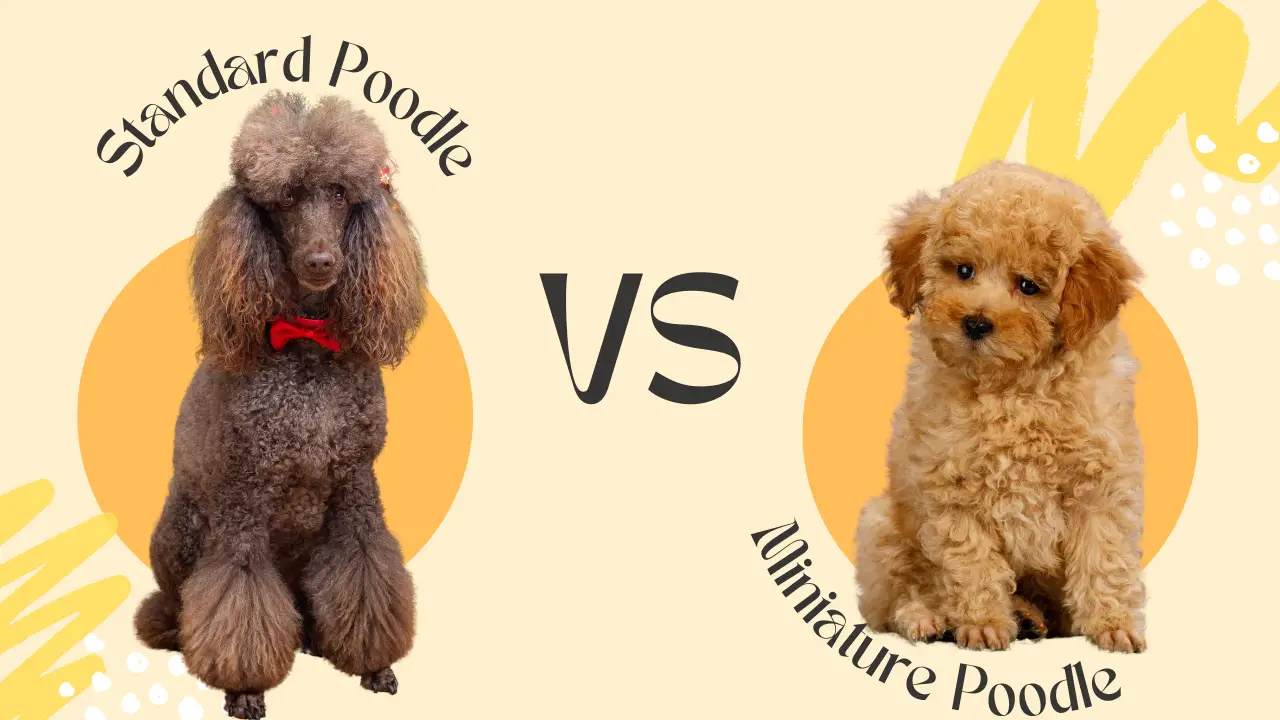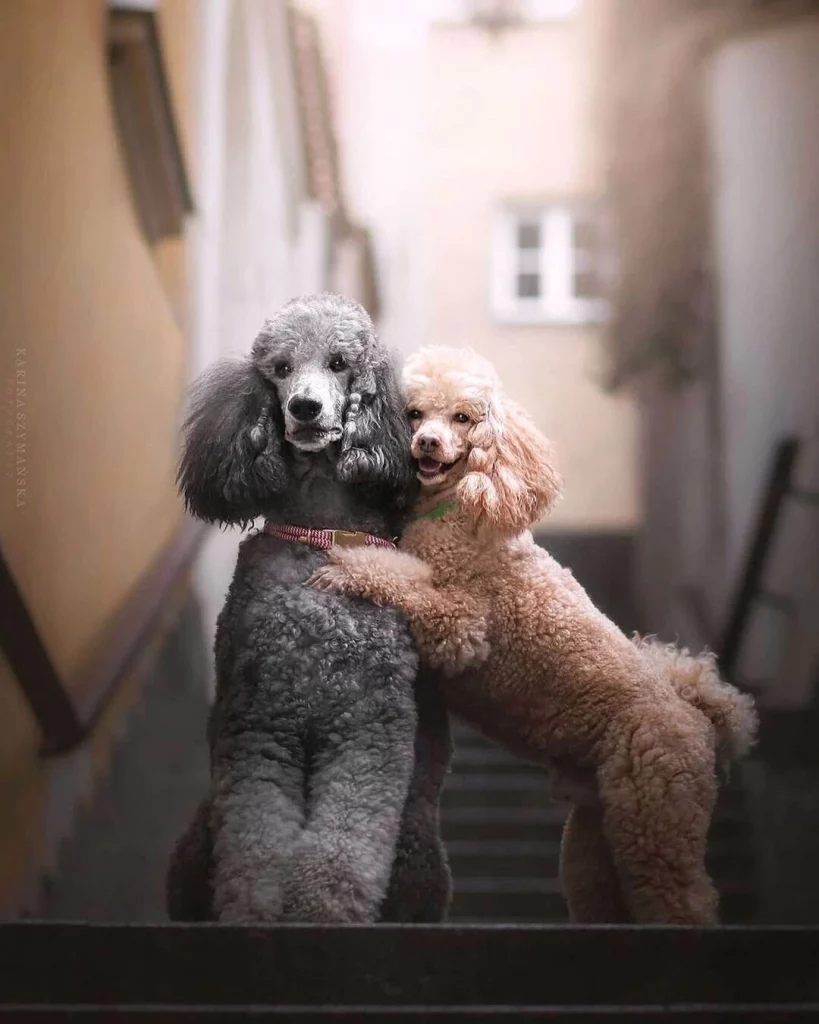Poodles are an epic breed to own, irrespective of their gender, personality, and size.

But if you are looking for a specific personality, temperament, or quality in a dog, knowing the differences between each type of Poodle might be important.
To help you with your choices, today we’re going to look at two of the most popular types: the Standard Poodle and Miniature Poodle.

Read our Smart Poodles - Smart Tricks eBook for only $2.99
Dive into a treasure trove of engaging tricks and tips designed specifically for your poodle!
What Will You Learn? 👇
History
To understand both types of Poodles, we have to dive back into their history to get a bigger picture. There are some unique differences in each breed type even though they come from the same family. To familiarize yourself with the Poodle breed, this ancient breed can be traced back to Germany.
Why Germany?
Well, Poodles were a dock kept for noblemen to hunt waterfowl such as ducks and birds. Their soft curly coat made them great swimmers in the water, allowing them to catch animals easily. Back then, it was only the Standard Poodle who was in existence and did such things. After some time in Germany, this dog became so popular it spread to France.
The breed itself became a sign of wealth for many aristocrats and ladies on their arms. It also became crowned as the national dog of France and appeared in circuses. During their circus period around the 1800s, the Standard was bred to be smaller, leading to the Miniature. Alongside being a circus dog, back then, the Miniature Poodle was regularly used for hunting truffles.
While these two Poodles were quite the hunters and swimmers, today, they’re mainly just kept as domestic animals.

Size comparison (height and weight)
Yes, we get it. There might be a giveaway in the Poodle’s name, but the Standard is larger than the Miniature Poodle. You might be wondering, how big exactly?
| Breed | Height | Weight |
| Standard Poodle | 45-60cm / 17-24 inches | 18-32kg / 45-70lbs |
| Miniature Poodle | 25-38cm / 10-15 inches | 5.4-9kg / 12-20lbs |
As you can see above, there’s quite a big difference in sizes between both Poodles. Because of this, if you’re planning on owning a Standard Poodle, it’s recommended that you only bring them into your home if you have a yard so they can have space to run around and stretch their legs. At the same time, a Miniature Poodle is small enough to fit into an apartment or a flat.
Temperament comparison
Personality is everything when it comes to owning a dog. A dog’s personality is not a one size fits all type. You might be an owner that’s looking for a shy, cuddly and reserved dog. Yet you also could be someone who’s looking for a naughty, mischievous and energetic dog. To help aid your decision, let’s break down the personality traits in each breed.
Standard Poodle Temperament
Standard Poodles are highly intelligent dogs, so smart that they’re very easy to train and learn quickly from a young age. Due to their constant thinking nature, they require lots of attention from their owners and need to be mentally and physically stimulated, so they don’t become bored easily.
The best way to provide them mental stimulation is through agility classes, advanced obedience classes, games like Hide and Seek, or using Kong toys. These dogs are not aggressive; however, they have mild watchdog tendencies, meaning they will stand alert against strangers and any unwelcome guests in your home.
They’re very polite and eager to please dogs, meaning they will fit in well with other animals or humans in your family. On the contrary, if you work a lot outside your home, this breed can get lonely and develop separation anxiety easily.
Miniature Poodle Temperament
The Miniature Poodle is a friendly dog breed that is full of confidence. Don’t be fooled by its small size, the way it walks it will command your attention. Compared to the Standard Poodle, it has a similar level of intelligence and is also easy to train. Even though they may have a small element of stubbornness in them, this can be overcome if you shower them with affection.
Again, these Poodles have an easy to please personality, and they love to shower their owners with affection. They also have a guard dog nature; however, their bark is a lot quieter than a Standard Poodle.
Exercise & living needs

If you’re planning on owning a dog, you must be willing to dedicate a sufficient amount of time to raise it. In particular, you should provide it with enough exercise each day to live a healthy life. Depending on the dog breeds, the amount of exercise can vary. This is relevant to the Standard and Miniature Poodle, as there are some slight differences.
Standard Poodle exercise requirements
As Standard Poodles are medium to large sized dogs, they require a lot of exercise to use up their energy and stamina. On average, it’s recommended that you take them out for exercise each day for 60-90 minutes. If you’re planning on walking them, they can walk for around 0.5-3 miles a day.
Miniature Poodle exercise requirements
If you don’t have a lot of time on your hands, then owning a Miniature Poodle might be more of an appealing option to you. Generally, a Miniature Poodle will require around 60 minutes of exercise a day which is a lot less than a Standard Poodle. This exercise quota can easily be achieved through a game of fetch or a walk.
While both breeds need a lot of physical exercise, they also require equal mental stimulation. Don’t forget to provide them with brain-teasing games like fetch, hide and seek, and more.
Grooming
If you’re not familiar with the Poodles coat, it’s soft, curly, or wavy and tends to shed very little. This is because it has a single coat, and it does not shed much between seasons regardless of its size. Because of this, it’s a great dog for people who have allergies as it won’t trigger them much.
Even though they’re hypoallergenic, don’t be deceived by their grooming requirements; for both types of Poodle, they’re a bit demanding and don’t differ much. If you plan on owning either type, you should brush them each day to stop their coat from matting.
If their coat becomes matted, it can cause moisture to enter their fur, increasing the risk of infection and also add sores on their skin. It would help if you also aimed to wash their coat every 4-6 weeks using a special dog shampoo. It’s also a good idea to take them to a vet once a month to have their coat trimmed.
Moreover, this is also a dog breed irrespective of size that needs to have its ears checked frequently. What I mean by this is that all types of Poodle have floppy ears that need to be checked weekly to make sure there is no dirt, bacteria, or moisture in them. The best way to clean their ears is by using cotton tissues to remove them.
Lifespan comparison (common genetic issue)

Wouldn’t it be great if dogs lived as long as humans? I wish this too. Unfortunately, though, dog years are a lot shorter than ours. This can be a major decision-maker when bringing in any breed into your family.
When it comes to the Standard Poodle, their average life expectancy is 12-15 years. On the contrary, a Miniature Poodle’s life expectancy is 13-15 years, which is slightly longer. However, I can’t always guarantee that either type of Poodle will live in that time frame; they could live a lot longer or even less.
While you can’t predict how long they live, you can put preventative measures in place to help extend their life as long as possible. One of which is knowing about all the potential health problems they could face and their side effects.
Standard Poodle health problems
Sometimes a Standard Poodle may develop the following health conditions:
- Hip dysplasia: This is where a dog’s ball and socket don’t grow and fit into place. As a result, they can have a lot of mobility issues. Such signs in a Standard Poodle are limping, and treatment normally involves surgery.
- Addison’s disease: A hormonal disease where a Standard Poodles adrenal gland produces too little cortisol. Typical signs of this are increased lethargy, vomiting, diarrhea, increased urination, and more. The treatment for this is through medication.
- Cataracts: A cloud-like film develops in front of the Standard Poodle’s eyes, causing vision difficulties and leading to blindness. Treatment is normally required, which is surgery.
Miniature Poodle health problems
Sometimes a Miniature Poodle may develop the following health conditions:
- Entropion: This is where their eyelid rolls inwards, causing a lot of pain and irritation.
- Epilepsy: A neurological condition that can cause a lot of seizures. The treatment for such seizures usually involves lifelong medication.
- Hyperthyroid: This is when a Miniature Poodles body produces too much of the thyroid hormone. As a result, their metabolic rate gets put at a dangerous level and can cause rapid heavy breathing, depression, diarrhea, enlarged thyroid gland, and more. Treatment for this condition usually involves surgery and radiation therapy.
As mentioned earlier, it’s not always guaranteed that these Poodles will get these conditions, but you must be aware of them and take them to the vets twice a year to rule them out.
Which is better for you?
So, the big question. Is the Standard Poodle or the Miniature Poodle a better breed to own? Well, the truth is the answer is all down to you! There’s not that much difference in these two breeds apart from their size, life expectancy, and exercise requirements. They tend to have similar personalities and grooming requirements. To help make your mind up, you should visit both breeds in person and see for yourself.
Do you have any preference towards the Standard and Miniature Poodle? Let us know in the comments down below.
Marko is the founder and author at PoodleHQ, where he blends profound expertise with formal training in Animal Behavior and Canine Genetics. With multiple generations of poodles under his care, he’s a breed connoisseur, honored with the Canine Care Excellence Award and lauded by the International Pet Enthusiasts Association.

